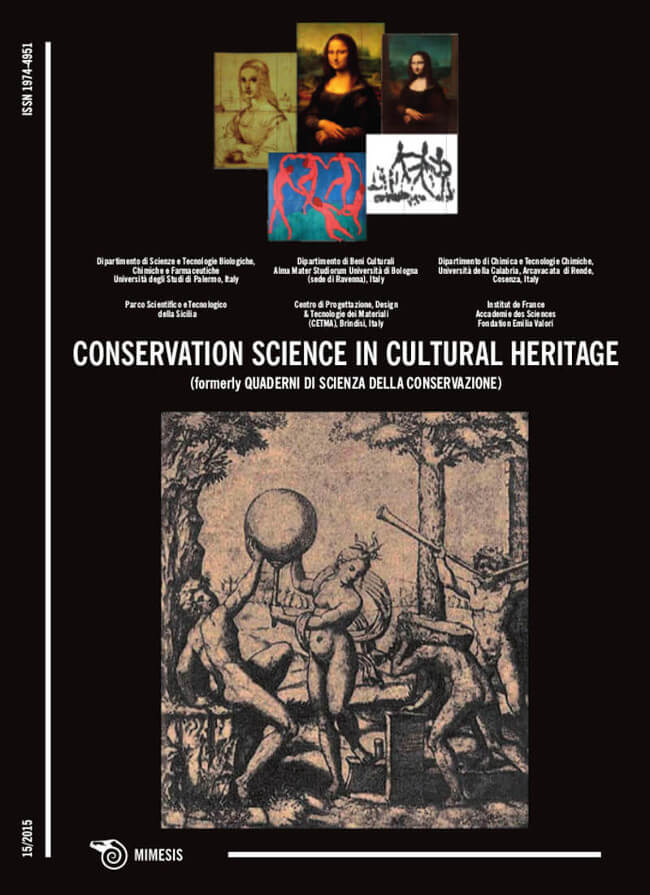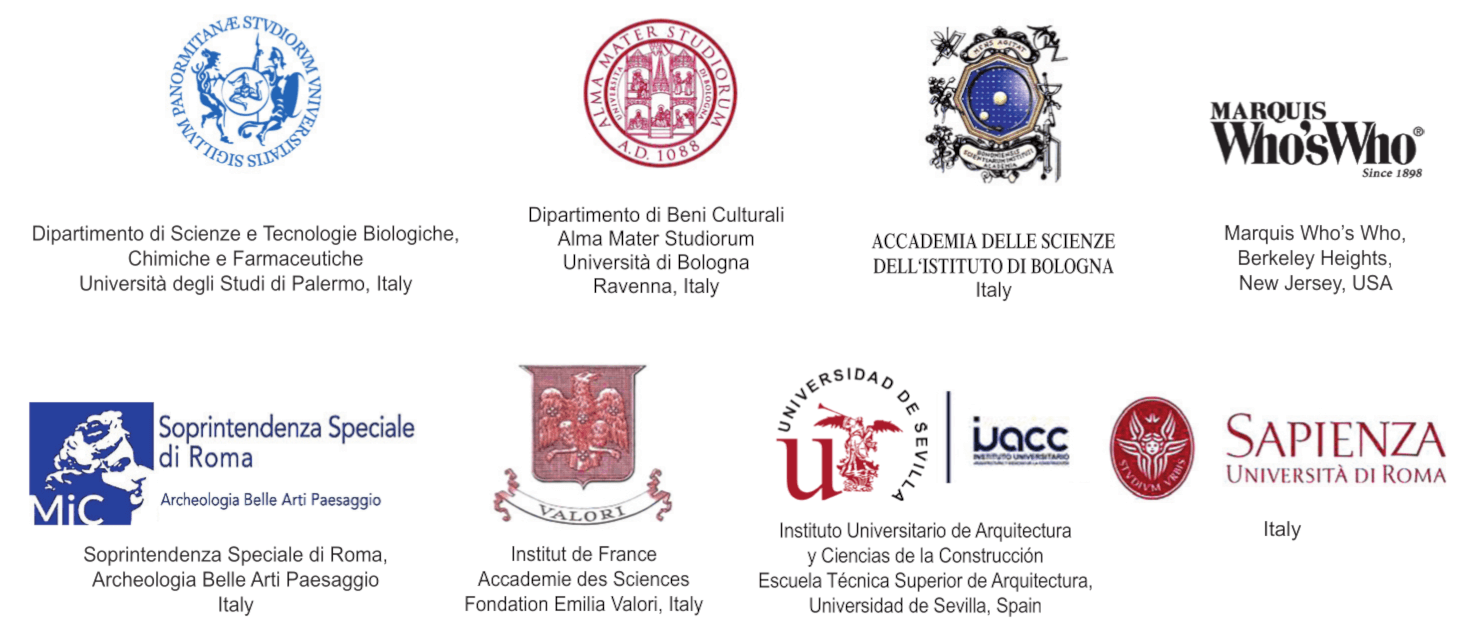Bioremoval of Sulphate Layer from a 15th Century Polychrome Marble Artifact
DOI:
https://doi.org/10.6092/issn.1973-9494/6177Keywords:
biocleaning, bacteria, desulfovibrio vulgaris, sustainable restorationAbstract
This case study shows the application of viable bacterial cells for removing undesired deposits from the surface of a stone polychrome bas-relief, exhibited at the Interdisciplinary Gallery of Sicily Palazzo Abatellis (Palermo). Diagnostic studies carried out during the restoration were aimed at characterizing the technique of execution and understanding the degradation processes. The results of the XRF and FTIR investigations showed that on large areas of the artifact’s surface, stratified deposits with a significant presence of sulfates were present. For bioremoval of the deposits, viable bacterial cells belonging to the species Desulfovibrio vulgaris, were utilized in gelled solution form, evaluating and comparing the effectiveness of this cleaning with that of the desulfating agents usually employed. The results demonstrate that by using the colonised substrate as a nutritional source in their natural metabolic processes, this bacterial species can be used to obtain high efficiency and selectivity of action, representing a valid alternative to the use of traditional chemical agents.References
GONZALES JM., 2003, Overview on existing molecular techniques with potential interest in cultural heritage. In C. Saiz-Jimenez (ed.), Molecular Biology and Cultural Heritage, pp. 3-13, Balkema Publishers, Lisse/Abingdon/Exton/Tokyo
PALLA F., FEDERICO C., RUSSO R., ANELLO L., 2002, Identification of Nocardia restricta in biodegraded sandstone monuments by PCR and nested-PCR DNA amplification. FEMS Microbiology Ecology, 39, pp. 85-89.
PALLA F., ANELLO L., PECORELLA S., RUSSO R., DAMIANI F., 2003, Characterisation of bacterial communities on stone monuments by molecular biology tools. In C. Saiz-Jimenez (ed.), Molecular Biology and Cultural Heritage: pp. 115-118. Balkema Publishers, Lisse/Abingdon/Exton/Tokyo.
PALLA F., 2012, Analytical techniques. In B. Fabbri (ed.), Science and Conservation for Museum Collections, pp. 459-470, Nardini, Firenze.
PALLA F., BILLECI N., MANCUSO FP., PELLEGRINO L., LORUSSO LC., 2010, Microscopy and molecular biology techniques for the study of biocenosis diversity in semi-confined environments. Conservation Science in Cultural Heritage,10, pp. 185-194.
PALLA F., MANCUSO FP., BILLECI N., 2013, Multiple approaches to identify bacterial taxa in archaeological waterlogged wood. Journal Cultural Heritage 14, pp. 61-64.
PASQUARELLA C., BALOCCO C., PASQUARIELLO G., PETRONE G., SACCANI E., MANOTTI P., UGOLOTTI M., PALLA F., MAGGI O., ALBERTINI R., 2015, A multisciplinary approach to the study of cultural heritage environments: Experience at Palatina library in Parma. Science of Total Environment, 536, pp. 557-567.
PALLA F., 2015, Biological risks for the conservation and exhibition of historicalartistic artefacts in confined spaces. In S. Lorusso, A. Natali, F. Palla (eds.), Risk management in the cultural heritage sector: museums, libraries and archives. MIMESIS EDIZIONI, Milano-Udine, in press.
GIOVENTÙ E., LORENZI PF., 2010, Valutazione dell’efficacia nell’utilizzo di microrganismi per la biorimozione delle croste nere dai materiali lapidei ed approfondimento delle metodologie applicative, OPD Restauro, 22, pp.127-138.
ZHU T., PAULO C., MERROUN ML., DITTRICH M., 2015, Potential application of biomineralization by Synechococcus PCC8806 for concrete restoration, Ecological Engineering, 82, pp. 459-468.
PERITO B., MARVASI M., BARABESI C., MASTROMEI G., BRACCI S., VENDRELL M., TIANO P., 2014, A Bacillus subtilis cell fraction (BCF) inducing calcium carbonate precipitation: Biotechnological perspectives for monumental stone reinforcement. Journal of Cultural Heritage, 15, pp. 345-351.
BIAGIOTTI L., TIANO P., MASTROMEI G., 1999, Bacterial Biomediated Calcite Precipitation for Monumental Stone Conservation: Methods of Evaluation, Journal of Microbiological Methods, 36, pp. 139-145.
CAPPITELLI F., TONIOLO L., SANSONETTI A., GULOTTA D., RANALLI G., ZANARDINI E., SORLINI C., 2007, Advantages of Using Microbial Technology over Traditional Chemical Technology in Removal of Black Crusts from Stone Surfaces of Historical Monuments, Applied and Environmental Microbiology, 73 (17), pp. 5671-5675.
CAPPITELLI F., ZANARDINI E., TONIOLO L., ABBRUSCATO P., RANALLI G., SORLINI C., 2005, Bioconservation of the marble base of the Pietà Rondanini by Michelangelo Buonarroti, Geophysical Research Abstracts, 7, pp. 66-75.
GIOVENTÙ E., LORENZI PF., VILLA F., SORLINI C., RIZZI M., CAGNINI A., GRIFFO A., CAPPITELLI F., 2011, Comparing the bioremoval of black crusts on colored artistic lithotypes of the Cathedral of Florence with chemical and laser treatment, International Biodeterioration & Biodegradation, 65, pp. 832-839.
ALBERGHINA M.F., BARRACO R., BRAI M., PELLEGRINO L., PRESTILEO F., SCHIAVONE S., TRANCHINA L., 2013, Gilding and pigments of Renaissance marble of Abatellis Palace: non-invasive investigation by XRF spectrometry, XRay Spectrometry, 42, pp. 68-78.
GIUSTI A., 1996 Il Colore ritrovato: Esperienze di restauro di scultura in pietra dipinta in Il colore nel Medioevo. Arte, simbolo tecnica. Atti delle giornate di studi Lucca 5-6 Maggio 1995, pp. 67-76, S. Marco Litotipo, Lucca.
MOROPOULOU A., BISBIKOU K., TORFS K., VAN GRIEKEN R., ZEZZA F., MACRI M.1998, Origin and growth of weathering crusts on ancient marbles in industrial atmosphere, Atmospheric Environment, 32, pp. 967-982.
EL-METWALLY A., RAMADAN A., 2005, The role of air pollutants and sewage waste in acceleration of degradation of the Islamic Cultural Heritage of Cairo. NATO Science Series, IV: Earth and Environmental Sciences, 38, pp. 363-370.
PERUZZI R., 1983, La conservazione dei materiali lapidei: cause di degrado ed interventi diagnostici in La pietra, interventi di conservazione e restauro, pp.71-87, Congedo Editore, Lecce.
LAZZARI L., LAURENZI TABASSO M., 1986, Il deterioramento della pietra in Il restauro della pietra, CEDAM, Padova, pp. 1-87.
BORGIOLI L., GIOVANNONI F., GIOVANNONI S., 2001, Un nuovo supportante per la pulitura degli affreschi, il Carbogel, Kermes: arte e tecnica del restauro, 44, pp. 63-68.
TROIANO F., GULOTTA D., BALLOI A., POLO A., TONIOLO L., LOMBARDI E., DAFFONCHIO D., SORLINI C., CAPPITELLI F., 2013, Successful combination of chemical and biological treatments for the cleaning of stone artworks, International Biodeterioration & Biodegradation, 85, pp. 294-304.
CAMPANI E., CASOLI A., CREMONESI P., SACCANI I., SIGNORINI E., 2007, L’uso di Agarosio e Agar per la preparazione di “Gel Rigidi”, n. 4, CESMAR7, Padova.
MATTEINI M., MOLES A., 2010, Solventi e soluzioni in La chimica nel restauro. I materiali dell’arte pittorica, pp. 89-135, Nardini Editore, Firenze.
MATTEINI M., NEPOTI MR., 1996, Controllo analitico dei metodi di de-solfatazione per la rimozione del gesso nelle pitture murali e in altri manufatti litici, OPD Restauro, 8, pp. 66-79.
BOSH-ROIG P., RANALLI G., 2014, The safety of biocleaning technologies for cultural heritage, Frontiers in Microbiology 5: 155
Downloads
Published
How to Cite
Issue
Section
License
Copyright (c) 2015 Manuela Martino, Salvo Schiavone, Franco Palla, Lorella Pellegrino, Evelina De Castro, Annalisa Balloi
Copyrights and publishing rights of all the texts on this journal belong to the respective authors without restrictions. Authors grant the journal right of first publication.This journal is licensed under a Creative Commons Attribution 3.0 Unported License. (full legal code)See also our Open Access Policy.






